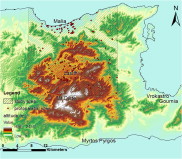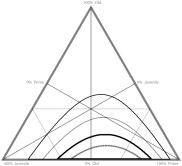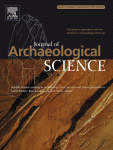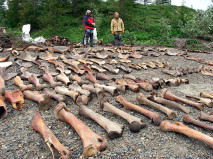| New Volume/Issue is now available on ScienceDirect |
| | Special Issue: Satellite remote sensing in archaeology: past, present and future perspectives | |
| | 9. | Cartography of the archaeological surveys taken from an Ikonos stereo-pair: a case study of the territory of Hierapolis in Phrygia (Turkey) Original Research Article
Pages 2051-2060
G. Di Giacomo, I. Ditaranto, G. Scardozzi
Highlights► We highlights the case of Hierapolis in Phrygia where archaeological surveys are in progress. ► We create a very detailed cartography for archaeological purpose from high-resolution satellite images.► We obtain a space-map of the entire area from an ortho-rectified Ikonos image.► We extracted vectorial thematic elements and positioned the archaeological data collected during survey.► We have obtained a large scale cartography (1:10,000 in scale) of areas that are very rich in archaeological evidence, filling the gaps caused by the lack of updated maps in appropriate scale.
| |
| | Original Research Articles | |
| | 12. | Evidence for variability among squash seeds from the Hoxie site (11CK4), Illinois Original Research Article
Pages 2079-2093
Mary L. Simon
Highlights► Provides a numerical analysis of Cucurbita pepo seeds recovered from an archaeological site in northern Illinois, USA. ► Defines three groups based on seed sizes. ► Compares seed size groups to sizes from modern varieties and archaeological collections. ► Discusses implications in terms of introduced Mesoamerican cultivated subspecies and native cultivated subspecies. ► Addressed questions of hybridization and speciation in Eastern North America.
| |
| | 16. | New evidence for Upper Palaeolithic small domestic dogs in South-Western Europe Original Research Article
Pages 2123-2140
Maud Pionnier-Capitan, Céline Bemilli, Pierre Bodu, Guy Célérier, Jean-Georges Ferrié, Philippe Fosse, Michel Garcià, Jean-Denis Vigne
Highlights► Small dogs from three French archaeological sites from the end of the Paleolithic. ► Risks of miss-identification between small early dogs and dholes. ► Underline the morphologic diversity among Paleolithic dogs’ populations.
| |
| | 19. | Dietary adaptation during the Longshan period in China: stable isotope analyses at Liangchengzhen (southeastern Shandong) Original Research Article
Pages 2171-2181
Rheta E. Lanehart, Robert H. Tykot, Anne P. Underhill, Fengshi Luan, Haiguang Yu, Hui Fang, Cai Fengshu, Gary Feinman, Linda Nicholas
Highlights► Dietary adaptation, Longshan Culture, Late Neolithic, ca. 2600–1900 B.C. ► Liangchengzhen regional center, Shandong Province, China. ► Stable isotope analysis (δ13C, δ15N, δ18O) of faunal and human remains, guan sherds. ► Dietary interpretation, increased rice cultivation and consumption at Liangchengzhen.
| |
| | 20. | Para-masticatory wear facets and their functional significance in hunter–gatherer maxillary molars Original Research Article
Pages 2182-2189
Luca Fiorenza, Stefano Benazzi, Ottmar Kullmer
Highlights► In this study we analyze the maxillary molar wear areas of several hunter-gatherer specimens. ► We have found particular wear areas associated with dental chipping (and named para-facets). ► We study these areas applying the OFA method on 3D digital models of teeth. ► The results show dip direction differences between normal wear facets and para-facets. ► The para-facets creation is not related to normal mastication but to tooth-tool uses.
| |
| | 21. | Palm reading: a pilot study to discriminate phytoliths of four Arecaceae (Palmae) taxa Original Research Article
Pages 2190-2199
Rohan S.H. Fenwick, Carol J. Lentfer, Marshall I. Weisler
Highlights► We examined leaf phytoliths of four economically important species of palm. ► Multivariate analysis has potential for distinguishing phytolith assemblages. ► Classifying ancient palm phytolith assemblages can illuminate cultural events. ► Palm phytolith analysis at Watom Island supports inferences of past horticulture.
| |
| | 22. | First ancient bovine DNA evidence from India: difficult but not impossible Original Research Article
Pages 2200-2206
Nandita Singh, Pramod Joglekar, Krzysztof Koziol
Highlights► Here for the first time, we have successful in isolating ancient DNA from Indian cattle sample. ► Fifteen samples ranging from 4000 years to 1000 years old were analysed for extraction of ancient DNA. ► We were able to obtain DNA and sequence the partial mitochondrial D loop in 3 of the 15 bovine fossil samples.
| |
| | 23. | Palaeohabitat of first settlement sites 1500–1000 B.C. in Guam, Mariana islands, western Pacific Original Research Article
Pages 2207-2221
Mike T. Carson
Highlights► An island-wide terrain model of Guam is refined according to a series of site-specific geoarchaeological excavations for reconstructing site settings and palaeohabitat landscape during 1500–1000 B.C.► The earliest settlement in Guam occurred 1500–1000 B.C. during a period of 1.8 m higher sea level and different island terrain and coastal ecosystem than was available after 1000 B.C. ► First settlement of Guam and generally of first Neolithic expansion into the remote Pacific Islands now can be understood in this context of a palaeohabitat configuration no longer existing some centuries later.
| |
| | 24. | Re-examining the chemical evaluation of diagenesis in human bone apatite Original Research Article
Pages 2222-2230
Charlotte L. King, Nancy Tayles, Keith C. Gordon
Highlights► FT-Raman spectroscopy can aid diagnosis of diagenetic change in bone. ► FT-Raman spectroscopy reveals patterns of ionic substitution invisible to FTIR. ► Groundwater flow contributes heavily to fluoridation of human bone. ► Substitution and secondary mineralisation reflects elemental composition of soil.
| |
| | 25. | Integrated geophysical surveys for the subsurface mapping of buried structures under and surrounding of the Agios Voukolos Church in İzmir, Turkey Original Research Article
Pages 2231-2242
Mahmut G. Drahor, Meriç. A. Berge, Caner Öztürk
Highlights► The integrated use of geophysical techniques can be effective and useful in the investigation of indoor structures. ► This work demonstrates the importance of the integrated techniques in searching for possible hidden subsurface structures in standing historical buildings. ► This study is the first indoor application of magnetic gradiometry. ► Finally, the usage of combined geophysical techniques gives us a fairly complete and valuable model of the subsurface characteristics of historical buildings
| |
| | 27. | Recognising burnt vein quartz artefacts in archaeological assemblages Original Research Article
Pages 2251-2260
Killian Driscoll, Julian Menuge
Highlights► Experimental open fire burning to distinguish burnt from unburnt quartz lithics. ► Examining visible characteristics, fragmentation rate, and spatial distribution. ► Burnt and unburnt samples were examined macro- and microscopically. ► Microscopic detection of fluid inclusion decrepitation diagnostic of quartz burning. ► Macroscopic changes diagnostic of burning where similar unburnt quartz available for comparison.
| |
| | 30. | Deletion/Substitution/Addition (DSA) model selection algorithm applied to the study of archaeological settlement patterning Original Research Article
Pages 2293-2300
Ricardo, Fernandes | Geert, Geeven | Steven, Soetens | Vera, Klontza-Jaklova
Graphical abstract
Highlights► GIS-based statistical methodological approach to the study of archaeological settlement patterning. ► Deletion/Substitution/Addition (DSA) selection algorithm provides an optimal archaeological model choice. ► Combined use of Receiving Operator Characteristic (ROC) curves, and variable ranking facilitate understanding of settlement patterning causation.
| |
| | 31. | Geochemical methods for inferring seasonal occupation of an estuarine shellmound: a case study from San Francisco Bay Original Research Article
Pages 2301-2312
Peter Schweikhardt, B. Lynn Ingram, K. Lightfoot, E. Luby
Highlights► Geochemical analysis of mollusk shell fragments from SF Bay Area shellmound. ► Ages of sampled data range from to ∼3500 BP to ∼200 BP. ► Comparison of chemistry of shell edge versus random point indicates season of harvest. ► Permits inference of seasonal occupation/resource use patterns of mound users. ► Generally evidence for autumn use, but seasonality varies through occupation period.
| |
| | 33. | An assessment of morphological criteria for discriminating sheep and goat mandibles on a large prehistoric archaeological assemblage (Kerma, Sudan) Original Research Article
Pages 2324-2339
Roz Gillis, Louis Chaix, Jean-Denis Vigne
Highlights► Dental and mandible morphological criteria for distinguishing sheep and goat, were assessed using a unique archaeological collection of complete caprine skeletons from Kerma, Sudan. ► The performance of individual criteria was scored for reliability of the species identification and efficiency of the criteria in identifying either species. ► Criteria alone and in combination were tested in three age classes. ► The results are species specific profiles are possible, increase in these profiles will increase our understanding prehistoric caprine husbandry.
| |
| | 37. | Remodelling the past – Archaeometrological analysis applied on Birka weight material using a 3D scanner & Computer-Aided Design Original Research Article
Pages 2378-2386
Joakim Schultzén
Highlights► Introduction of a new method for digital archaeometrological analysis. ► Comparison suggests new method equal the precision of the traditional method in recreating the original mass of ancient weights ► Archaeometrological analysis of a population of weights from the Viking Age trading site of Birka, Sweden confirms adherence to the Baltic Sea system of mass. ► Discrepancies within the Baltic Sea system of mass identified and discussed.
| |
| | 38. | Optical spectroscopy as a rapid and low-cost tool for the first-line analysis of glass artefacts: a step-by-step plan for Roman green glass Original Research Article
Pages 2387-2398
Wendy Meulebroeck, Peter Cosyns, Kitty Baert, Hilde Wouters, Simone Cagno, Koen Janssens, Herman Terryn, Karin Nys, Hugo Thienpont
Highlights► Optical spectroscopy used to study green coloured Roman glasses. ► CIE1931 colour values reveals the type of colorant (iron, copper, …). ► CIE1931 colour values identifies fragments fabricated under similar conditions. ► CIE1931 colour values identifies fragments which might belong to a same object.
| |
| | 39. | The application of histomorphometry and Fourier Transform Infrared Spectroscopy to the analysis of early Anglo-Saxon burned bone Original Research Article
Pages 2399-2409
Kirsty E. Squires, Tim J.U. Thompson, Meez Islam, Andrew Chamberlain
Highlights► We apply thin-section and FTIR analysis to Anglo-Saxon burned bone. ► We examine the effects of burning on bone through macroscopic observation, histomorphometry and FTIR spectroscopy. ► Macroscopic examination produce a general idea of temperature, the more technical methods employed in this study offer a more precise temperature range. ► The temperature of Anglo-Saxon funerary pyres ranged from 600 °C to over 900 °C. ► The differential cremation between upper and lower limbs was statistically significant at the 0.05 level.
| |
| | 40. | Archaeometallurgical study of the brass cases from the Akko 1 shipwreck Original Research Article
Pages 2410-2419
D. Ashkenazi, D. Cvikel, N. Iddan, E. Mentovich, Y. Kahanov, M. Levinshtein
Highlights► Archaeometallurgical analysis of brass cases from shipwreck was preformed. ► All artifacts were produced of rolled sheets and the cases were hand-made. ► Typological study of the cases suggests they were designated to contain artillery quills. ► Dating is suggested to be during the first half of the nineteenth century.
| |
| | 41. | Cross-platform program for likelihood-based statistical comparisons of mortality profiles on a triangular graph Original Research Article
Pages 2420-2423
Timothy D., Weaver | Ryan H., Boyko | Teresa E., Steele
Graphical abstract
Highlights► Most faunal analyses use mortality profiles to investigate age-at-death patterns. ► A triangular graph, or ternary diagram, remains a popular method for doing this. ► Comparisons made visually, but differences hard to interpret without statistics. ► We offer a likelihood-based method for statistical comparisons on a triangular graph. ► A cross-platform computer program that implements our approach is available.
| |
| | 42. | New radiocarbon dating of the transition from the Middle to the Upper Paleolithic in Kebara Cave, Israel Original Research Article
Pages 2424-2433
N.R. Rebollo, S. Weiner, F. Brock, L. Meignen, P. Goldberg, A. Belfer-Cohen, O. Bar-Yosef, E. Boaretto
Highlights► Kebara Cave has remains from the Middle to Upper Paleolithic (MP-UP) transition. ► MP-UP transition is the last migration of Modern Humans from Africa into Eurasia. ► This new set of dates makes Kebara Cave the earliest evidence of MP-UP transition. ► Interdisciplinary and new field excavation methods secure the contexts in Kebara. ► Higher dating precision achieved through new laboratory and selection methods.
| |
| | 44. | Three statistical methods for sex determination in extant and fossil caprines: assessment of the Rupicapra long bones Original Research Article
Pages 2450-2460
Diego Arceredillo, Asier Gómez-Olivencia, Alfonso García-Pérez
Highlights► Three statistical methods were applied to forty-nine metrical variables of chamois. ► k-means was the best performing method. ► k-means was applied to chamois sample from the Pleistocene site of Valdegoba, Spain. ► Young adult male chamois were the most hunted prey by Neandertals from Valdegoba. ► Valdegoba male chamois were larger and thus more dimorphic.
| |
| | 48. | Petrodatabase: an on-line database for thin section ceramic petrography
Pages 2491-2496
Patrick Quinn, Dominic Rout, Luke Stringer, Timothy Alexander, Alasdair Armstrong, Sam Olmstead
Highlights► On-line database for the petrographic analysis of pottery and other ceramic artefacts. ► Bespoke standalone relational database with a Web-based user interface. ► Available free and accessed via any Internet connection and modern Web browser. ► Facilitating access to comparative material and extending known range of ceramic compositions. ► Helps to preserve the extensive collections of delicate ceramic thin sections that exist worldwide.
|
|

Núcleo de Arqueologia e Paleoecologia Laboratório G22 FCHS - Departamento de História, Arqueologia e Património Universidade do Algarve Campus de Gambelas 8005-139 Faro, PORTUGAL Mail: nap.ualg@gmail.comUrl: http://nap-ualg.blogspot.com
|







